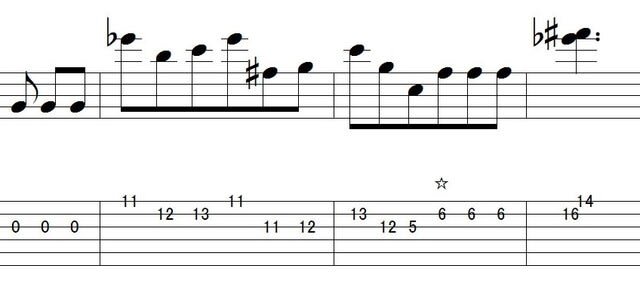今まで当たり前のように(正解だと思って)決めつけていたポジションがまちがっていたかもしれない
・・という考察、
ギター初心者の学生時代、ラジカセにかじりついて一生懸命コピーしていたこの曲
当時の譜面などは正確ではなかったので何度も耳コピしたり友人に聞いたり・・
When I was a student and a guitar beginner, I was glued to my radio cassette player and copying this song with all my might.
The musical scores at the time weren't accurate, so I copied them by ear many times or asked friends...
そんな当時でも「まさかここは間違っていないだろう・・」と思っていた場所が
数十年経った今改めて聴いていたら「おやっ?」となり...
念入りに耳コピしてみたら実は・・・?!
長い年月まったく気にならなかったということも含め、自分的にかなりショックな出来事だった..
When I listened to the parts I used to play as a beginner, decades later, I thought, ``Huh?''
Then, when I carefully copied it by ear, I realized that it might actually be like this... It was a rather shocking event...
①「Burn」
ここがこう聴こえた・・~This is what it sounded like...

↓

「今の自分にはこう聴こえる」・・This is what it sounds like to me now
普通、3弦4フレットの音はKey:Gmの曲では使わない。
使うなら3弦3フレット、、そしてこれは今まで見てきたどんな楽譜にもそう書いてあったし
みんながそう弾いていたと思う
Normally, the note on the 3rd string and 4th fret is not used in Key: Gm songs.
If you're going to use it, use the 3rd string and 3rd fret...and this is written that way in every sheet music I've ever seen, and that's how everyone played it (I think).
自分も数十年間そう思って弾いてきた
まさかここで3弦4フレットの音を弾くなんて、そんな発想すら浮かばない
もし狙って意図的に弾いているのであれば「やっぱりこの人は普通とは違う!」
凡人にはとてもできない発想
That's how I thought and played for decades.
I can't even imagine playing the note on the 3rd string and 4th fret here.
If he was playing intentionally, it would make me think, ``This person is amazing after all!''
スキャロップ指板なので強く押さえると若干音がシャープするがそうでもなさそう、、
3弦3フレットを弾くつもりがうっかり3弦4フレットを弾いてしまったのだろうか?
それが一番落ち着く考えかもしれない・・
Since it's a scalloped fingerboard, the pitch will change slightly if you press hard, but it doesn't seem like that.
Did you accidentally play the 3rd string and 4th fret when you intended to play the 3rd string and 3rd fret?
That guess may be the best guess...but...
でも、3弦4フレットを意図的に弾いてみると・・
意外と変ではない・・しかもだんだん慣れてきた
逆に良い意味での”クセ”にさえ聴こえてきて、個性すら感じる
However, if you intentionally play the 3rd string and 4th fret...
It's not strange at all...and I'm getting used to it.
On the contrary, it even starts to sound like a quirk in a good sense, and even gives a sense of individuality.
もっといろいろ思うことはあるけどきりがないのでやめておく・・
There are many more things I want to say and think about, but I'll stop because there's no end to it...
とりあえず現時点では「ここは3弦4フレットが正解だった」・・と思っている
(気のせいかもしれないが、ここは3弦4フレットにしておきたい・・笑)
But my current feeling is that the 3rd string and 4th fret was the correct answer...
《P.S.》
ついでにこんなことも・・5:34~あたりのイントロのリフがこう聴こえる(・.・;)?
Also, this is what the intro riff around 5:34 sounds like.?
かすかにスイッチングしてるような音とトーンの変化を確認・・これはなんだろう?
このリフのこのタイミングにトグルスイッチを切り替えるのはとても不自然
もしそうならリフ前にフロントで弾いていたことになる・・
I heard a slight switching sound and a change in tone... What is this?
It's very unnatural to switch the toggle switch at this timing of this riff.
If so, were you playing with the front pickup until just before?Was it really necessary?
(余談)
トグルスイッチをとても神経質に切り替えるアーティストをコピーしていた経験があるので仮にここで切り替えていたとしても特におかしくないし不可能な所作ではないと思う
ただ、もしそうならその理由(根拠)に興味が湧く(笑)
”あの方”はスイッチを頻繁に切り替えるという話で有名?だったし
意味なく演奏中に切り替えてまだ戻したり、ピックを指先で回してみたり・・
とそんなことを気分でやることに関しての理解はある、、
にしてもここでの切り替えはかなりトリッキーな行為だと思う(笑)
天才、奇才にしか知りえない理由で”なにか”があった・・
という結末を望んでしまいがちではあるのだが...(*⁰▿⁰*).。o○
(単なる編集作業での出来事か・・?)
I have experience copying artists who switch toggle switches very nervously, so I don't think it would be particularly weird or impossible if they were toggling here.
I just want to know the reason (reason) (lol)
I've heard that "that person" frequently switches the pickup selector.
It's understandable that people do such things depending on their mood, such as switching back and forth while playing without any meaning, or turning the pick around with their fingertips.
Even so, I think the switching here is quite tricky「トリッキー」 (lol)~"トリッキー" in Japanese(笑)
(※Nowadays in Japan, the word ``Torikki'' is used to mean ``something strange.'')
It would be more interesting if there was something ``something'' that only geniuses and geniuses could know about.
②「Lazy」 0:42~
こう聴こえた・・というよりも「Burn」と比べると比較的はっきり聴きとれる。
It sounded like this...or rather, it can be heard relatively clearly compared to "Burn".

↓

「Lazy」は曲中この(有名な)リフがKeyを変えて3回でてくる
This (famous) riff appears three times in the song "Lazy" with different keys.
Fm→Gm→Am
気になる点は「ライブ盤」でのAm部分、
The point I pointed out was the Am part on the "live version"
このようなフレーズの場合、5フレットをクォーターチョーキングするのが定石だが
そうではなくはっきりと6フレットを弾いてるように聴こえる・・
It is standard practice to quarter choke the 5th fret, but it seems like he is clearly playing the 6th fret instead.
I don't think Japanese people have this idea either.
だとしたらこの発想にビックリ
要は「3弦5フレットの音と3弦6フレットの音の中間の音」を得るための手段として
「3弦5フレットのクォーターチョーキング」だけではなくて
「3弦6フレットの実音」も交えてフレーズを組み立てている・・という解釈をするのであれば
常人はなかなかそこまで考えないだろうし神経すりへる、、
そんな次元でギターのフレーズを考えたり組み立てる発想は持ち合わせていなかった・・
コピーすら恐れ多いと思った
そもそもクォーターチョーキング自体のクセが日本人には根付いてないと感じていた
欧米人は無意識にかけているのだろう
ブルーノートと同様に”血(本能)”なのかもしれない、、
In the first place, I feel that the habit of quarter choking itself is not ingrained among Japanese people.
Westerners do this unconsciously (I think)
Is it “blood (instinct)” like Blue Note?
日本で言えば民謡のこぶしのようなものだろうか・・
これを弾く時は5フレットには当然クォーターチョーキングをかけて、
「5フレットのC音~6フレットのC#音~7フレットのD音」
を半音で弾き分ける感覚を持ち合わせながらこのフレーズを弾くことに意義がある・・
ということだろうか?
(・・ちょっと何言ってるかわかんない (っ'-')╮ =͟͟͞͞🎸 )
ブルーノート、クォーターチョーキングは奥が深い
Keyでいうとマイナーとメジャーの違いは3rdの音の半音の違いだけれど
I feel that Blue Note's quarter chalking is profound.
In terms of keys, the difference between minor and major is the difference in the 3rd note by a semitone...
それはあくまで”頭の中の知識”であって実際は「物理的に1/2に割り切れる」ものではない、、
🎹
例えば、ピアノの「C#」と「D♭」の黒鍵は今では1つだが
昔は違う音と認識されていたようで「C寄りのD♭」「D寄りのC#」と2つ黒鍵があったらしい・・
In terms of black piano keys, "C# and D♭" are not originally the same.
Apparently there are two semitones (black keys), "D♭ closer to C" and "C# closer to D".
さらに鍵盤ではなくヴァイオリンのようなフレットのない楽器やチョーキングなどの表現においては
1/2半音~1/4半音~・・と無数の微妙な音程を表すことができる
In addition, when it is expressed with a violin without frets or with bending instead of a keyboard,
You can express countless subtle pitches such as 1/2 semitone to 1/4 semitone...
加えて「純正律」などの概念も考えると音~音階~フレーズ~音楽・・はとても割り切れない世界になってくる
今回の「Burn」と「Lazy」の取り上げたポイントは似ていると思った
どちらも半音~クォーターの”感覚的なピッチ”にまつわる話だ
This issue of “Burn” and “Lazy” are similar.
Both stories are about pitches ranging from semitones to quarters.
よってこれらは「たまたまこう弾いていただけ」という結末にはしたくない
Therefore, I don't want it to end up as ``I just happened to play this way.''
その奥に見え隠れする、なにか音楽の奥深い話に繋がってゆく予感がする・・
ちなみに「そんな細かいことど~でもいい!」と言う人もいるだろうし
それを”細かいこと”だとは感じない人もいるだろう
それがどうでもいいことならニュートンは万有引力を発見していなかっただろうし
考古学や天文学などが好きな人はこのようなことを深く掘り下げることに興味を持つだろう・・
以前はギター教室の生徒さん10人に1人くらいはこのような話に興味を持ってくれる人がいた・・
By the way, some people say, "I don't care about such small details!"
Some people may not feel that it is a "minor detail".
Some might say that if it didn't matter, Newton wouldn't have discovered universal gravitation.
Personally, I like archeology and astronomy, so I like digging deep into things like this.
In the past, there was a music class student who was equally interested in stories like this, about one in 100.
(過去形・・・) It's past tense (lol) ・・(っ'-')╮ =͟͟͞͞🎸
最近は見かけない・・
傾向?
※余談:最近宇宙の話にも興味を持たれなくなってきたと感じる
(・・みんな宇宙なんてどうでもよくなってしまったのだろうか?)
黄砂が飛んでくるのと同じように太陽から様々な電磁波、宇宙線が飛んできて地球上に影響を与えているという
太陽系の惑星は皆宇宙の海に浮かんでいるので宇宙の天気はとても大事なこと
いずれTVの天気予報の中で”宇宙天気情報”をやるべきだ!・・とはNASAの宇宙飛行士さんの話で私もそれには大賛成
As a side note, I feel like there are more and more people around me who aren't interested in space these days.
...Does everyone think that space doesn't matter?
All the planets in the solar system are floating in the ocean of space, so space weather is very important, and one day TV weather forecasts should feature "space weather"!
That's what a NASA astronaut said, and I totally agree with that!(lol)🐱
という今回の出来事・・(*⁰▿⁰*)
以前は楽しかった考察も最近ではつかれてしまうのでそろそろ卒業しようかと考える・・
いつかどこかでなにかのきっかけにでもなれば
《関連記事/Related article》
《Guitar consideration-1-》・あのめんどうなギターソロに決着を!
《Guitar consideration-2-》今になって気づいた!ここ、1音だけ違う音弾いてる?
《Guitar consideration-3-》・コードの押さえ方が?


































